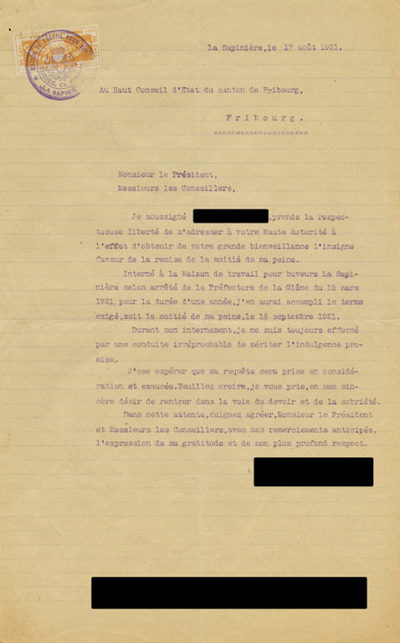Ways out of the correctional labour facility: a petition for release
 Petition for release dated 17th August 1921 from the correctional labour facility for drunkards «Sapinière», part of the facilities of Bellechasse, addressed to the State Council of the Canton of Fribourg, p. 1
Petition for release dated 17th August 1921 from the correctional labour facility for drunkards «Sapinière», part of the facilities of Bellechasse, addressed to the State Council of the Canton of Fribourg, p. 1 Legal framework
In 1919 the Canton of Fribourg passed the Gesetz über die Wirtshäuser (Law on public houses): whoever was classified as a «drunkard causing nuisance and dangerous alcoholic» could be confined in a labour facility designed especially for such people for a period of one to three years. The correctional labour facility for drunkards named «Sapinière» (Fir tree House) in Bellechasse took up its activity on 1st August 1920. A.B. had been assigned to serve his detention in this facility.
The law set forth that the director of the facilities of Bellechasse could ask the State Council to release a detainee on probation if the latter fulfilled two conditions: he had served at least half of his detention period and had given «proof of improvement».
Procedure
The procedure to be released on probation from the correctional facilities of Bellechasse was set forth in the Gesetz über die Wirtshäuser of 1919: the inmate had to submit a petition to the State Council of the Canton of Fribourg. The director of the facilities added his recommendation on the back of the letter. Often it consisted of just a few, very concise lines. On the basis of this expertise, the State Council decided whether the inmate had given «proof of improvement» and could thus be released on probation or whether he had to serve his full sentence. If the inmate was released in advance on probation, he was subject to the surveillance of the communal authorities until the end of the detention period originally ordered. If the former detainee did not behave as required during the probation period, he could be brought back to the correctional facility to serve the rest of the sentence.
Use of sources
This source shows how the detainee argued for his release on probation. Together with the other files in his dossier, this document shows how the article of the Law on public houses concerning release on probation was actually applied. We do not known how the director of the facilities of Bellechasse and the State Council of Fribourg measured the required «proof of improvement». In his petition, A.B. declares that he always strove for an «irreproachable» conduct during his detention, but he does not give any concrete examples. In his expertise, the director declares he is fully satisfied with A.B.’s conduct and working performance. But, he too, does not supply any information regarding the exact conduct and actual performance intended. In this case, the State Council finally decided to release A.B. on probation after he had served half of his sentence.
This petition for release is a typical example. In order to gain information on the release practice of the time at the Bellechasse correctional labour facilities, it is necessary to analyse and compare other petitions for release. Moreover, researchers have to analyse also the law texts, which set forth the legal framework for release on probation.
M. Häsler Kristmann/Translation
Source
Petition for release dated 17th August 1921 from the correctional labour facility for drunkards «Sapinière», part of the facilities of Bellechasse, addressed to the State Council of the Canton of Fribourg.
Signature: Staatsarchiv des Kantons Freiburg (StAF/AEF): AEF DPd 2001.
 previous source
previous source
 next source
next source


